Evolution and Heredity: How Does Life Change?
I. Overview: Cell Reproduction, Heredity, and Evolution
The disciples of cell biology, evolution, and heredity were all born from 1850-1902, largely through the work of Charles Darwin (evolution), Walther Flemming (cell biology), and Gregor Mendel (heredity). Darwin published The Origin of Species in 1859, summarizing the evidence that life changes over time, and proposing that this changed occurred as a consequence of Natural Selection--that organisms with traits that work well in an environment are more likely to survive and reproduce than other organisms that lack these traits; and thus, these traits that work well in that environment would be "passed on" in more descendants, and will accumulate in a population from one generation to the next. However, Darwin had no idea HOW tratis were "passed on" from parents to offspring during reproduction (though observations showed that they certainly were; offspring looked like parents!). In 1866, Gregor Mendel conducted breeding experiments with pea plants to try and figure this out. Contrary to the commonly held idea that the "heritable information" (the stuff passed down) were fluids from the male and female that blended (thus giving a mixture of traits in the offspring), Mendel showed that the "heritable information" was 'particulate' - discrete separate things (now called genes) that did not 'blend', but were inherited in new combinations in the offspring. Work in 1878 by Walther Flemming identified chromosomes in cells and showed that they were divided equally between 'daughter cells' when a cell divided, and Sutton and Boveri in 1902 showed that the movement of chromosomes during the production of egg and sperm ("gametes") could explain Mendel's patterns of heredity. They proposed that the heritable information was contained in the chromosomes. (It wouldn't be until 1952, in the experiments of Alfred Hershey and Martha Chase, that DNA in chromosomes--and not the proteins in chromosomes--was the gentic material. And of course, in 1953, James Watson and Francis Crick proposed that DNA was a double helix with complementary A-T and C-G pairings). So, we are going to take things in chronological order to see how or understanding grew loigcally over time.
A. Evidence for Evolution by Common Descent
1. The Earth is old: James
Hutton (1726-1797): Hutton was the first great british geologist.
He compared Hadrian's wall - which looks new but was 1600 years old (122 AD)
- with natural rock outcrops that were strongly weathered. Hutton concluded
that the natural outcrops must be 100's of times older. He also examined an
important formation at Siccar Point, where one series of nearly vertical strata
is overlain by another series of horizontal strata. This is now called an 'unconformity',
and Hutton explained it as follows. Based on Steno's laws of superposition,
the bottom vertical sediments must have been laid down first, and they must
have been laid down horizontally. Ages must have passed between each deposit,
as each turned to rock. Then, uplifts must have occurred to bend them into a
vertical aspect. Long periods of erosion must take place to wear that uplift
flat, followed by the long intervals of time needed to deposit the second horizontal
series. Also, if erosion and deposition acted slowly (as current observations
show), then it must have taken a really long time to erode mountains or build
up marine deposits (White Cliffs of Dover). He concluded that this slow, 'uniformitarian'
cycle of deposition, uplift, erosion, and deposition meant that the Earth was
unfathomably old. Indeed, the cycle may mean that it's age might not be discoverable.
In short, Hutton concludes, the Earth has "no vestige of a beginning, no prospect
of an end."
2. The patterns in the fossil record show change
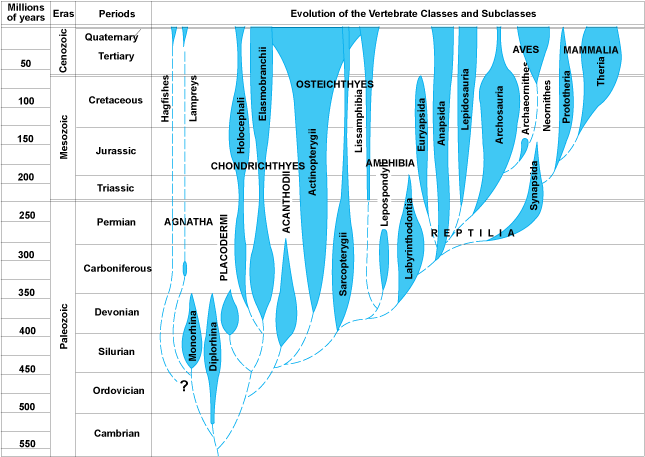 Paleontology
provided a variety of interesting patterns. First, there were extinct forms
that were different from the species alive today. Although some earlier natural
philosophers suggested that the creatures might still exist in some unexplored
corner of the globe, that was a less satisfying hypothesis in the mid-1800's...
most areas of the globe had been visited by Europeans. Also, the idea of extinction
was repugnant to some people on theological grounds. If God had created a perfect
world, then extinction renders that creation imperfect. Also, if species could
go extinct since the creation, could species also come into existence since
the creation? Just how dynamic was this system?
Paleontology
provided a variety of interesting patterns. First, there were extinct forms
that were different from the species alive today. Although some earlier natural
philosophers suggested that the creatures might still exist in some unexplored
corner of the globe, that was a less satisfying hypothesis in the mid-1800's...
most areas of the globe had been visited by Europeans. Also, the idea of extinction
was repugnant to some people on theological grounds. If God had created a perfect
world, then extinction renders that creation imperfect. Also, if species could
go extinct since the creation, could species also come into existence since
the creation? Just how dynamic was this system?
Darwin was impressed by two major
patterns in the fossil record.
1. The major groups of animals accumulate
in an orderly manner'. Everything is not represented at the beginning. In vertebrates,
for instance, the fishes appear first, and exist throughout the rest of the
record. Amphibians appear next, followed by reptiles, mammals, and birds. So
it is not everything at the beginning, and it is not a replacement. Where did
mammals come from? Spontaneous generation had been refuted, so Darwin knew that
mammals had to come from other pre-existing animals. But the only completely
terrestrial vertebrates before mammals were reptiles.
2. A second major pattern occurred
within some lineages of similar organisms. Within some lineages, we seen orderly
change in the size or characteristics of species in a geological sequence. For
instance, consider the morphological patterns in a particular taxon (horses).
Fossils in a stratigraphic sequence are similar, but often have traits that
form a continuum...like the progressive loss of digits on the horse limb. And,
with each innovation, there are often radiations - a "spurt" in the
number of species that show this new trait. And finally, these species in recent
strat are more similar to living ('extant') species than the species found in
deeper, older strata. So, many of these transitional sequences terminate in
living representatives.
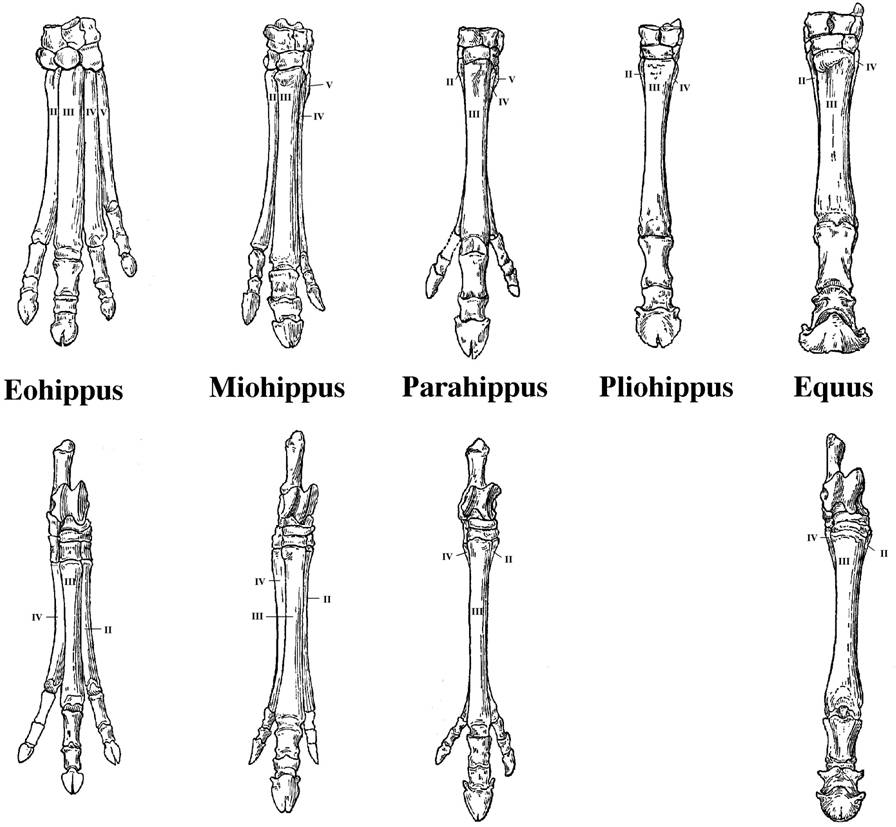
 3.
Comparative anatomy shows patterns related to the environment:
3.
Comparative anatomy shows patterns related to the environment:
Homologous Structures
Although having a different outward "look" and although used
for different purposes, they have an underlying similarity in structure - forelimbs
of vertebrates all have one long upper arm bone, two lower arm bones, a bunch
of wrist bones, and five digits. Darwin saw the similarity in structure as important.
An engineer builds different things for different purposes - cars, boats, and
airplanes are structurally DIFFERENT. Here, however, it seemed as if one basic
structure was modified for different uses. Darwin knew why siblings in a family
were similar - they had the same parents (ancestors). He reasoned that these
structural similarities in different species might be due to the same principle
- common ancestry. Also, he observed a correlation: Different uses correlated
with different environments. Could this correlation be causal?
Analogous
Structures
Organisms in the same environment often have a similar outward
structure or body plan. For example, flying animals all have an aerodynamic
wing that is wider at the front than at the rear. However, the wings of differnt
animals are differnt in underlying structure. Bats have fingers that support
the membraneous wing, whereas birds lack fingers and the body of the wing consists
of feathers. Insect wings don't involve the limbs at all (even though they have
6!). Again, Darwin observed this correlation with the environment: similar use
(and outward structure) in similar environments. Could this correlation be causal?
Vestigial Organs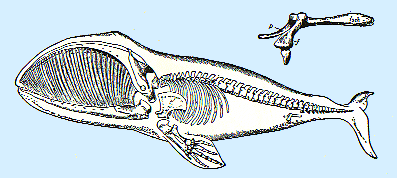
These are organs that have no function in one organism (where
they are 'vestigial') but they do function in other organisms. So, some whales
have hip bones, but no legs. Why do they have these bones? Darwin was struck
by the IMPERFECTIONS in nature, as much as the adaptations. Why do men have
nipples? Why do we have muscles that wiggle our ears? Why do we have strong
muscles in the front of our stomach, which are not "load-bearing", and weak
muscles at the base of our abdomen (which rupture in a hernia)? This is a reasonable
relationship in a quadraped, but not in a biped. Why do we have tail bones,
but no external tail? Again, these are NOT well-designed features. In fact,
attributing these imperfect designs to a perfect creator could be interpreted
as heretical. However, when we see them working in OTHER species, it suggests
that maybe we inherited them from common ancestors where they DID serve a function.
As a scientist, Darwin was trying to explain ALL the data (adaptations and imperfections),
he was not simply bringing forward only the data that supported a preferred
position (design).

4. Biogeography: Species distributions show patterns related to the environment:
Under similar environmental conditions, we find different
species filling similar ecological niches. Outward 'form' correlates with
ecological niche (role) across entire communities. So, in Australia, marsupials
fill the role of dog-like predator, cat-like predator, burrowing animal, ant-eater,
etc. These same roles are filled by outwardly similar placental mammals in South
America. However, the similarity between a wolf (placental) and a Thylacine
(marsupial - the 'tasmanian wolf') are strictly ANALOGIES. Their underlying
structure shows them to be quite different - a wolf is more similar to a ground
hog (both placentals) in underlying structure than to a thylacine. 
Islands often
have fewer species than a mainland - even a patch of mainland the same size.
As such, the patterns and interactions are often simpler to describe and understand.
For both Darwin and Alfred Russel Wallace (the other independent author of the
theory of evolution by natural selection), the study of islands was critical
in to the development of their ideas.
1. Distance correlates with the
uniqueness of the inhabitants: the animals on the Fauklands are the same
species as on the mainland, but the Galapagos fauna is composed of unique species,
found nowhere else:
"The natural history of these islands is eminently curious, and well deserves
attention. Most of the organic productions are aboriginal creations, found nowhere
else; there is even a difference between the inhabitants of the different islands;
yet all show a marked relationship with those of America, though separated from
that continent by an open space of ocean, between 500 and 600 miles in width.
The archipelago is a little world within itself, or rather a satellite attached
to America, whence it has derived a few stray colonists, and has received the
general character of its indigenous productions. Considering the small size
of the islands, we feel the more astonished at the number of their aboriginal
beings, and at their confined range. Seeing every height crowned with its crater,
and the boundaries of most of the lava- streams still distinct, we are led to
believe that within a period geologically recent the unbroken ocean was here
spread out. Hence, both in space and time, we seem to be brought somewhat near
to that great fact -- that mystery of mysteries -- the first appearance of new
beings on this earth." The Voyage of the Beagle - Darwin (1839).
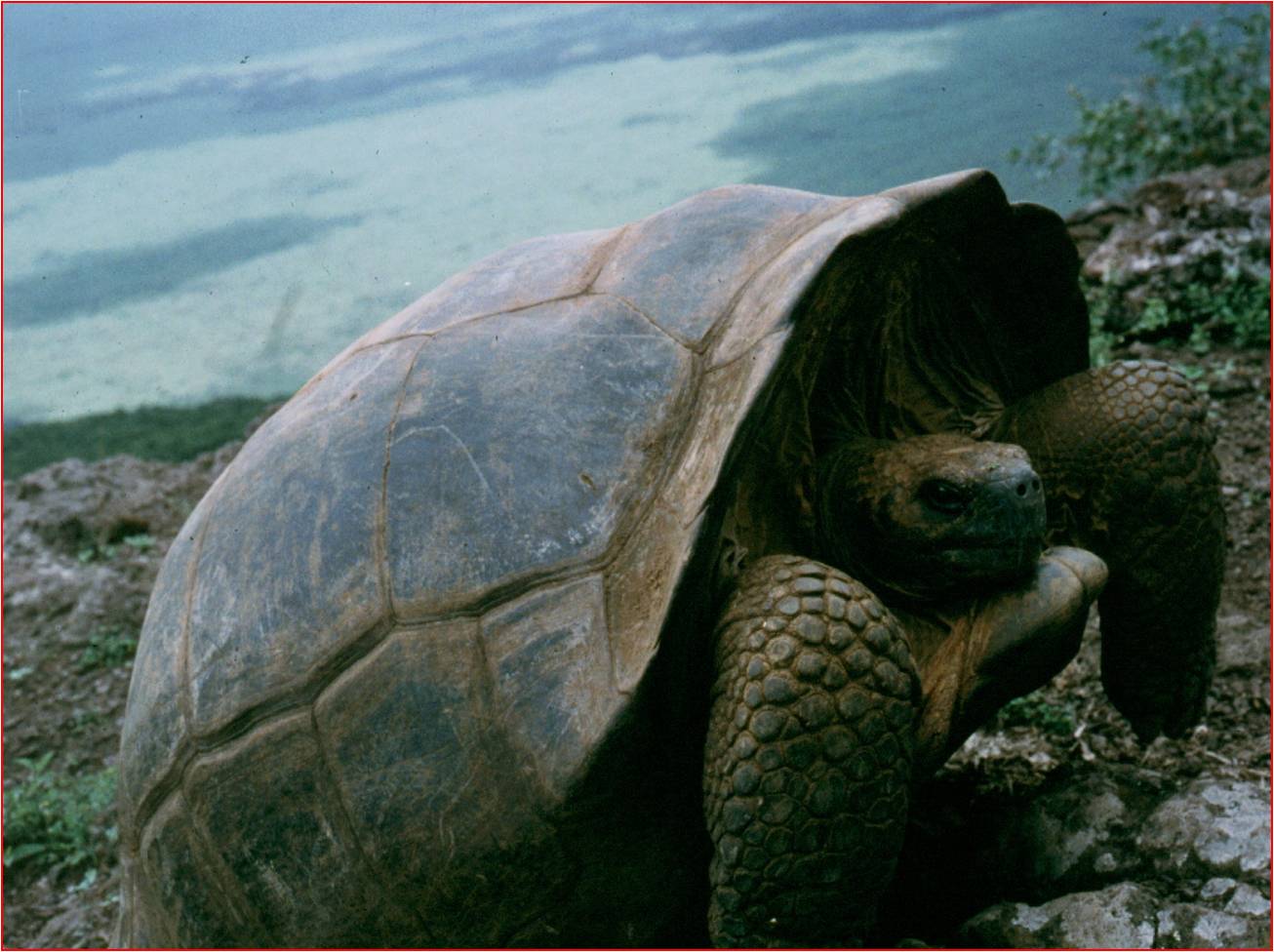 2. The Galapagos fauna:
2. The Galapagos fauna:
- It was related to american fauna,
yet different: the types of animals are new world animals.... there are iguanas
like the green iguana of Central and South America, but the iguanas are different
species. So, darwin describe it as " a world within itself, or rather,
a satellite of the Americas" .... it was different, but more like the American
fauna than any other...(no chameleons, for instance, which are old world lizards...)
- It was dominated by dispersive forms. This is critical. The communities are
dominated by reptiles, birds, and marine mammals. All of these organisms could
MIGRATE to the islands from the mainland. (Terrestrial mammals don't migrate
as well as terrestrial reptiles over open ocean. Throw a reptile in cold salty
water, and: 1) its metabolism slows down (its cold), so 2) its demand for food
and water decline; and 3) its scales protect it against water loss... which
is why reptiles do well in the desert, too. Throw a mammal in cold salt water,
and it's going to have a VERY tought time: 1) the temperature gradient between
its warm body and the cold ocean is very large - in order to maintain its high
body temperature against this gradient, it's metabolism has to INCREASE (to
produce more heat to compensate for the heat lost to the environment). This
increased metabolic demand will INCREASE the need for food and water... that's
probably in pretty short supply in the open ocean; and 2) water is lost quickly
from the skin to the salty ocean once the fur is wet... so, mammals are more
likely to starve or die of exposure than reptiles.
-
So, the islands are dominated by dispersive forms, and this suggests they came
from America. But if they came from America, WHY ARE THEY DIFFERENT SPECIES
THAN THOSE IN AMERICA? They must have changed since their arrival.
- There are even differences between
species on different islands. On the 14 species of finches - "Seeing this gradation
and diversity of structure in one small, intimately related group of birds,
one might really fancy that from an original paucity of birds in this archipelago,
one species had been taken and modified for different ends." The Voyage
of the Beagle - Darwin (1839) VIDEO
2. Argument
For Evolution as a Historical Fact:
Premise 1: Species
that are alive today are different from those that have lived previously.
Premise 2: Spontaneous Generation is refuted, so organisms
only come from other organisms.
Conclusion 1: Thus, the organisms alive today must have come
from those pre-existing, yet different, species.
Conclusion 2: There must have been change through time (evolution).
Conclusion 3: The fossil record, vestigial organs, and homologies
are all suggestive of descent from common ancestors.
Below, the figure from The Origin
of Species that shows Darwin's idea of descent from common ancestors.
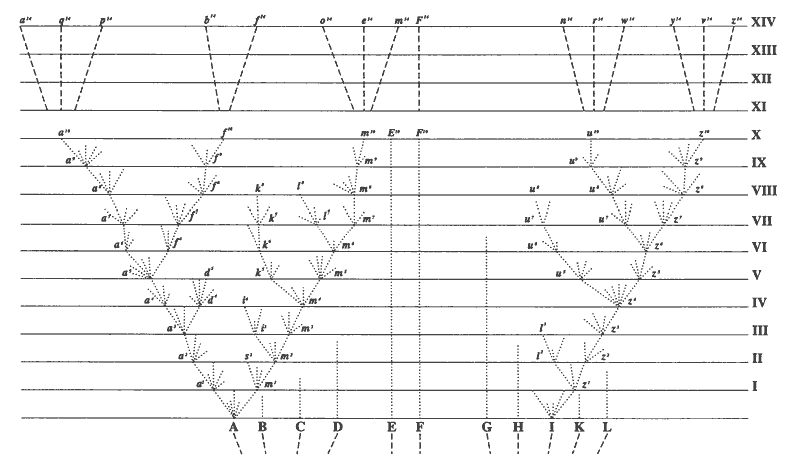
So, if species do change over time
(evolve), the next question is "How?" How does this change occur?
B. How does change occur? Natural Selection
In 1838, Darwin wrote in his notebook that he read Thomas Malthus's "Essay on the Principle of Population" which said that populations would grow until they were limited by some resource... like food or shelter. hen, there would be a struggle for existence. Darwin wrote in his notebook that he immediately appreciated that, in this struggle, those individuals best suited to acquire those resources would be at an advantage, and the traits that gave them this advantage would be passed on when these individuals reproduced. In The Origin of Species, Darwin begins by analogy; he reminds readers of the great changes we have made in domesticated species by choosing who gets to breed. He called this 'artificial selection'. With this foundation, reader's could appreciate that nature could do this too, by limiting survial and reproduction to only those who could acquire limited resources.
(Know this. Understand it. You WILL be asked to outline NS in this
very form.)
P1: Populations over-reproduce (Malthus)
P2: resources are finite (Malthus)
C1: Eventually, a population will grow until it becomes limited by its resources.
At that time, their will be a "struggle for existence" and most offspring
produced will die. (Malthus)
P3: Individuals in a population vary, and some of this variation is heritable (Darwin
- observations and animal/plant breeding)
C2: Variations will not have the same probability of survival and reproduction in
a particular environment; those well-suited to the environment will be more
likely to survive and reproduce than others, passing on the genes for these
adapted traits. There will be "Differential Reproductive Success" (Observations,
breeding).
C3: Over time, adaptive traits will accumulate and the characteristics in a population
will change. This is lineage evolution. (Like change in horse toes in a sequence
of fossil species, or like the change in the chihuahua lineage from the ancestral
wolves).
Corollary: Two sub-populations, separated in different environments, would be selected
for different traits and may subsequently lose the capacity to interbreed. At
this point, they are different biological species. This is Speciation and Radiational
Evolution. (like the production of different Finches, mockingbirds, etc. on
different islands in the galapagos, and like the radiation of St. Bernards AND
chihuahua's, which diverged from one another over time).
Darwin here provides a natural explanation
for why purposeful structures and behaviors occurs in nature. Through some process
unknown to him, variation arises in natural populations. These varieties differ
in terms of functional efficiency in a common environment; so some improving
an organisms probability of surviving and mating than others. Organisms with
these beneficial traits will leave more offspring, and the frequencies of these
beneficial characteristics will increase through time - much as humans select
for smaller and smaller dogs. He ends The Origin of Species (1859)
like this:
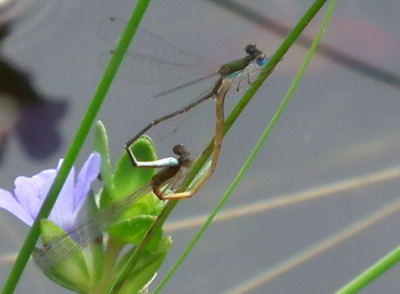 "It
is interesting to contemplate an entangled bank, clothed with many plants of
many kinds, with birds singing on the bushes, with various insects flitting
about, and with worms crawling through the damp earth, and to reflect that these
elaborately constructed forms, so different from each other, and dependent on
each other in so complex a manner, have all been produced by laws acting around
us. These laws, taken in the largest sense, being Growth with Reproduction;
Inheritance which is almost implied by reproduction; Variability from the indirect
and direct action of the external conditions of life, and from use and disuse;
a Ratio of Increase so high as to lead to a Struggle for Life, and as a consequence
to Natural Selection, entailing Divergence of Character and the Extinction of
less-improved forms. Thus, from the war of nature, from famine and death, the
most exalted object which we are capable of conceiving, namely, the production
of the higher animals, directly follows. There is grandeur in this view of life,
with its several powers, having been originally breathed into a few forms or
into one; and that, whilst this planet has gone cycling on according to the
fixed law of gravity, from so simple a beginning endless forms most beautiful
and most wonderful have been, and are being, evolved". - The Origin of Species (Darwin 1859).
"It
is interesting to contemplate an entangled bank, clothed with many plants of
many kinds, with birds singing on the bushes, with various insects flitting
about, and with worms crawling through the damp earth, and to reflect that these
elaborately constructed forms, so different from each other, and dependent on
each other in so complex a manner, have all been produced by laws acting around
us. These laws, taken in the largest sense, being Growth with Reproduction;
Inheritance which is almost implied by reproduction; Variability from the indirect
and direct action of the external conditions of life, and from use and disuse;
a Ratio of Increase so high as to lead to a Struggle for Life, and as a consequence
to Natural Selection, entailing Divergence of Character and the Extinction of
less-improved forms. Thus, from the war of nature, from famine and death, the
most exalted object which we are capable of conceiving, namely, the production
of the higher animals, directly follows. There is grandeur in this view of life,
with its several powers, having been originally breathed into a few forms or
into one; and that, whilst this planet has gone cycling on according to the
fixed law of gravity, from so simple a beginning endless forms most beautiful
and most wonderful have been, and are being, evolved". - The Origin of Species (Darwin 1859).
Study
Questions:
1. What observations
did Hutton make, and what did he conclude from these observations?
2. What two patterns
occur in the fossil record that impress Darwin regarding the hypothesis of evolution
and common descent?
3. What are homologous
structures? What correlations occurs with the environment?
4. What are analogous
structures? What correlation occurs with the environment?
5. How did
Darwin explain the existence of 'convergent communities"?
6. The Galapagos
are dominated by many unique species of reptiles, birds, and marine mammals. What did this
non-random assemblage suggest to Darwin about their origin, and how was evolution
implied?
7. Why were
the mockingbirds so critical to Darwin's ideas about the production of new species?
8. How did Darwin
use the comparative method and observations of 'artificial selection' to produce
the theory of 'natural selection'?
9. How were Malthus's
observations and conclusion relevant to the development of Darwin's theory?
10. Outline the
theory of natural selection as an argument, with three premises, 3 conclusions,
and a corollary.
 Paleontology
provided a variety of interesting patterns. First, there were extinct forms
that were different from the species alive today. Although some earlier natural
philosophers suggested that the creatures might still exist in some unexplored
corner of the globe, that was a less satisfying hypothesis in the mid-1800's...
most areas of the globe had been visited by Europeans. Also, the idea of extinction
was repugnant to some people on theological grounds. If God had created a perfect
world, then extinction renders that creation imperfect. Also, if species could
go extinct since the creation, could species also come into existence since
the creation? Just how dynamic was this system?
Paleontology
provided a variety of interesting patterns. First, there were extinct forms
that were different from the species alive today. Although some earlier natural
philosophers suggested that the creatures might still exist in some unexplored
corner of the globe, that was a less satisfying hypothesis in the mid-1800's...
most areas of the globe had been visited by Europeans. Also, the idea of extinction
was repugnant to some people on theological grounds. If God had created a perfect
world, then extinction renders that creation imperfect. Also, if species could
go extinct since the creation, could species also come into existence since
the creation? Just how dynamic was this system?

 3.
Comparative anatomy shows patterns related to the environment:
3.
Comparative anatomy shows patterns related to the environment: 


 2. The Galapagos fauna:
2. The Galapagos fauna: 
 "It
is interesting to contemplate an entangled bank, clothed with many plants of
many kinds, with birds singing on the bushes, with various insects flitting
about, and with worms crawling through the damp earth, and to reflect that these
elaborately constructed forms, so different from each other, and dependent on
each other in so complex a manner, have all been produced by laws acting around
us. These laws, taken in the largest sense, being Growth with Reproduction;
Inheritance which is almost implied by reproduction; Variability from the indirect
and direct action of the external conditions of life, and from use and disuse;
a Ratio of Increase so high as to lead to a Struggle for Life, and as a consequence
to Natural Selection, entailing Divergence of Character and the Extinction of
less-improved forms. Thus, from the war of nature, from famine and death, the
most exalted object which we are capable of conceiving, namely, the production
of the higher animals, directly follows. There is grandeur in this view of life,
with its several powers, having been originally breathed into a few forms or
into one; and that, whilst this planet has gone cycling on according to the
fixed law of gravity, from so simple a beginning endless forms most beautiful
and most wonderful have been, and are being, evolved". - The Origin of Species (Darwin 1859).
"It
is interesting to contemplate an entangled bank, clothed with many plants of
many kinds, with birds singing on the bushes, with various insects flitting
about, and with worms crawling through the damp earth, and to reflect that these
elaborately constructed forms, so different from each other, and dependent on
each other in so complex a manner, have all been produced by laws acting around
us. These laws, taken in the largest sense, being Growth with Reproduction;
Inheritance which is almost implied by reproduction; Variability from the indirect
and direct action of the external conditions of life, and from use and disuse;
a Ratio of Increase so high as to lead to a Struggle for Life, and as a consequence
to Natural Selection, entailing Divergence of Character and the Extinction of
less-improved forms. Thus, from the war of nature, from famine and death, the
most exalted object which we are capable of conceiving, namely, the production
of the higher animals, directly follows. There is grandeur in this view of life,
with its several powers, having been originally breathed into a few forms or
into one; and that, whilst this planet has gone cycling on according to the
fixed law of gravity, from so simple a beginning endless forms most beautiful
and most wonderful have been, and are being, evolved". - The Origin of Species (Darwin 1859).